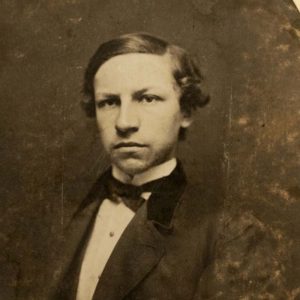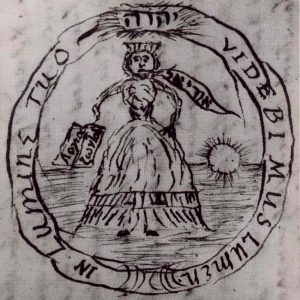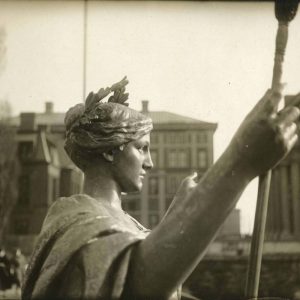She greets all visitors. She looks over all the students hanging out on the Low Library steps. She has the best seat in the house for Commencement. This week marks the anniversary of Alma Mater’s unveiling in 1903. But how well do you know Alma? Take our quiz to find out.
Give yourself one point for each correct answer:
1. How long has Alma graced the campus? Has she always been there?

While Alma was unveiled on September 23, 1903, Alma once left campus. In May 1978, Alma was removed from her marble platform and was taken for a restoration to the Tallix Foundry in Peekskill, NY. Alma’s throne had been damaged by a bomb in a 1970 demonstration. She returned to Morningside in September 1978.
Give yourself a bonus point if you knew about pre-Alma: In October 1901, a plaster model of Alma was installed in the pedestal so that “the sculptor, Mr. French, might get an idea of its symmetry with the surroundings and make such modifications as he might consider necessary.”
2. Who gifted Alma to Columbia?

Harriette Goelet presented the statue to Columbia in honor of her late husband, Robert Goelet, Class of 1860. The Goelet family offered to bear the cost of the statue up to $25,000. In 1978, when Alma was in need of a restoration, it was again the Goelet family who covered the cost.
3. Outside of Columbia, Alma’s sculptor, Daniel Chester French, is best known as the sculptor of which national monument?

If you guessed the Lincoln Memorial, you are correct. Daniel Chester French designed the 19-foot tall Lincoln statue, dedicated in 1922. He is also known in some circles for his John Harvard statue. You can see more of his work outside of the Alexander Hamilton (King’s College 1774-1776) Customs House downtown.
4. Who or what was the inspiration behind the Alma Mater? What is she modeled on?

Alma is modeled on Samuel Johnson’s drawing of the Seal of King’s College from 1755. But did you know . . . that in the early drawings, Alma resembled French’s earlier work The Republic, a centerpiece of the 1893 World’s Columbian Exposition, a standing Alma.
5. How tall is Alma?

The statue rises six and a half feet in height. If Alma were standing, she would be about ten feet tall.
6. What is Alma’s secret?

You may have heard the phrase “Have you found the owl?” Buried in the folds of her skirts, there is Alma’s hidden owl. Professor Dwight C. Miner claimed that the owl was French’s nod of loyalty to his fraternity, Psi Upsilon. However, French’s own daughter, Margaret French Cresson, claimed to set the record straight by saying that the owl was a symbol of wisdom.
7. Over the years, how has Alma’s “look” changed?

Originally, Alma was gilded in gold. As the gold leaf wore off, she came to wear a darker patina and became naturally weathered. For four weeks in 1962, Alma was dressed in bronze (!). Her beautiful patina is now actively maintained and cared for to ensure that Alma always looks her best.
8. Are there other Alma Maters?

Columbia is not the only home to an Alma Mater, although ours seems to be the oldest. You can find an Alma Mater in front of the University of Havana, created in 1919 by artist Mario Korbe. The University of Illinois also has an Alma, but this one has stood up from her throne. This sculpture by Lorado Taft was unveiled in 1929.
- If you received 7 to 8 points: Alma’s owl is so proud of you. You are a good friend of Alma’s.
- If you received 4 to 6 points: Well done. You have shared in Alma’s book of knowledge.
- If you received 0 to 3 points: We can help. Check out Julie Golia’s (GSAS 2010) article on Alma Mater on the University Archives website. You can learn more about Alma’s history, see historical photographs, and enjoy this loving account of Alma through the years.